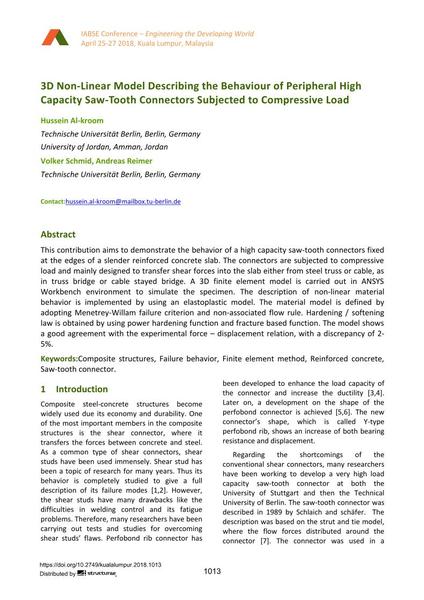3D Non-Linear Model Describing the Behaviour of Peripheral High Capacity Saw-Tooth Connectors Subjected to Compressive Load

|
|
|||||||||||
Bibliografische Angaben
| Autor(en): |
Hussein Faisal Al-Kroom
(Technische Universität Berlin, Berlin, Germany University of Jordan, Amman, Jordan)
Volker Schmid (Technische Universität Berlin, Berlin, Germany) Andreas Reimer (Technische Universität Berlin, Berlin, Germany) |
||||
|---|---|---|---|---|---|
| Medium: | Tagungsbeitrag | ||||
| Sprache(n): | Englisch | ||||
| Tagung: | IABSE Conference: Engineering the Developing World, Kuala Lumpur, Malaysia, 25-27 April 2018 | ||||
| Veröffentlicht in: | IABSE Conference Kuala Lumpur 2018 | ||||
|
|||||
| Seite(n): | 1013-1020 | ||||
| Anzahl der Seiten (im PDF): | 8 | ||||
| DOI: | 10.2749/kualalumpur.2018.1013 | ||||
| Abstrakt: |
This contribution aims to demonstrate the behavior of a high capacity saw-tooth connectors fixed at the edges of a slender reinforced concrete slab. The connectors are subjected to compressive load and mainly designed to transfer shear forces into the slab either from steel truss or cable, as in truss bridge or cable stayed bridge. A 3D finite element model is carried out in ANSYS Workbench environment to simulate the specimen. The description of non-linear material behavior is implemented by using an elastoplastic model. The material model is defined by adopting Menetrey-Willam failure criterion and non-associated flow rule. Hardening / softening law is obtained by using power hardening function and fracture based function. The model shows a good agreement with the experimental force – displacement relation, with a discrepancy of 2- 5%. |
||||
| Stichwörter: |
Finite-Elemente-Methode (FEM) FEM Stahlbeton
|
||||
